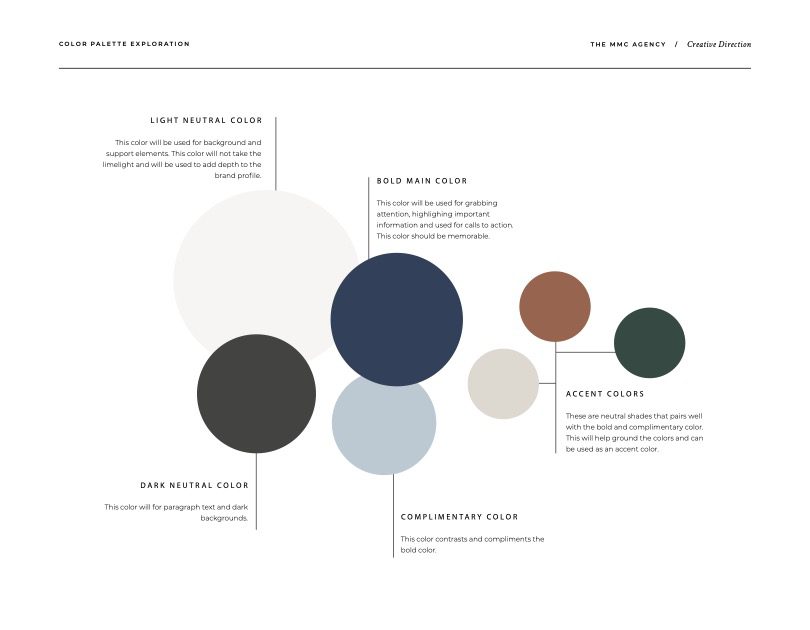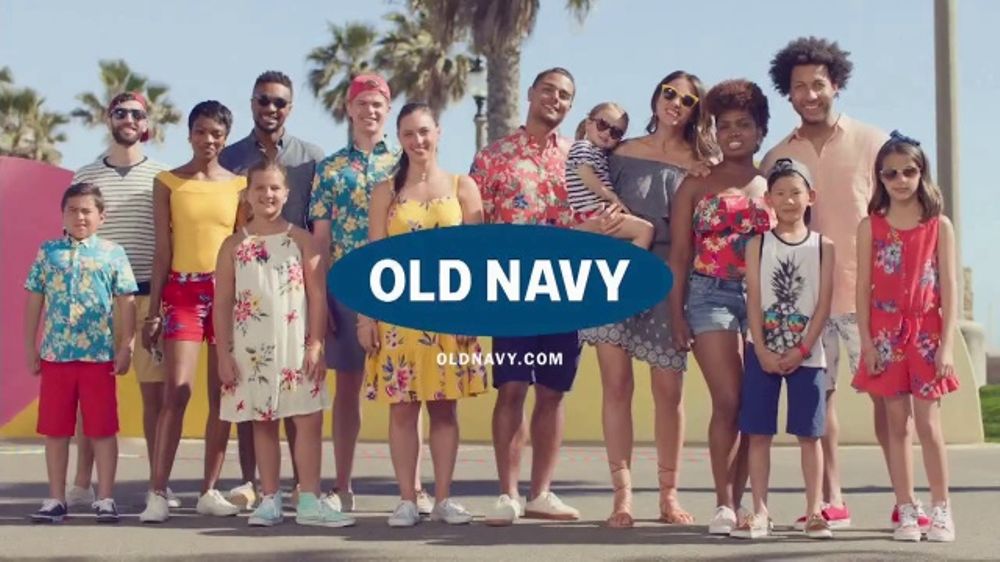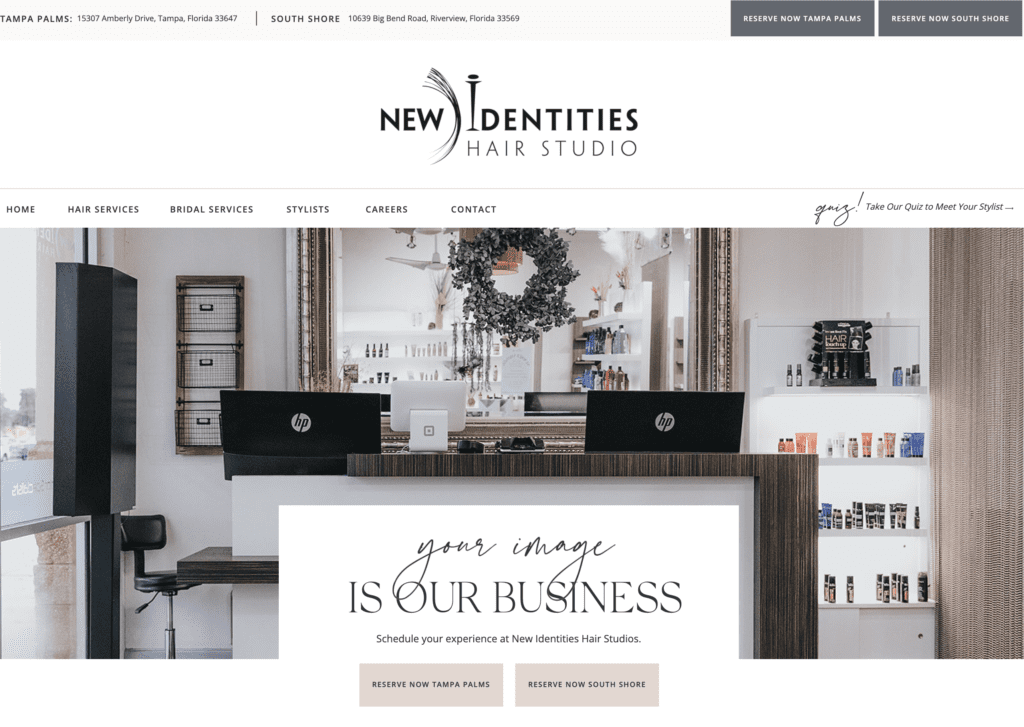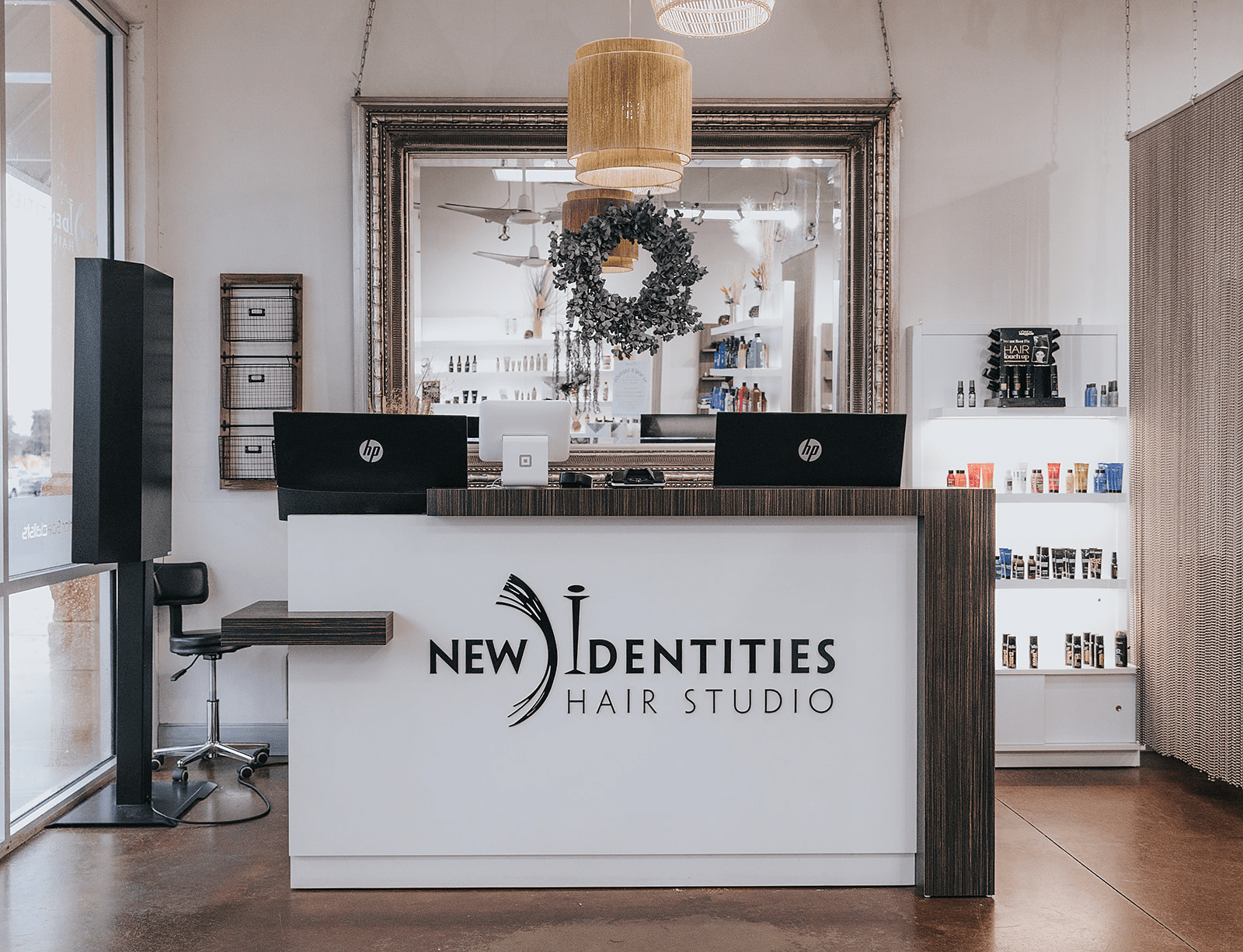What is branding and identity? If you’re asking this question, you might be researching how to build a unique brand identity – or be wondering if you’ve done enough for an existing brand you created.
Think of brand identity as a brand’s personality. That’s right – just like you or I might walk into the room and be instantly recognized, a brand identity helps customers know your company by the way it looks, acts, talks, and operates.
Before we break down the unique components of a brand identity – let’s look at a few recognizable examples that will help you see branding and identity in action.
Old Navy
Old Navy is a strong business with a playful brand identity. If you asked for audience insight about who Old Navy serves, the answer would likely be – everyone! Or, specifically, families, men, women, and dogs. Why? Because Old Navy consistently shows families, pets, and people of all genders, ages, and sizes in their branding. That signals the “who” that they serve right away. Commercial participants frequently dance, jump, and socialize, which signals playfulness. And thanks to the $5 tees they made famous for July 4th, the brand image (a perception a consumer has about a particular brand) is one that offers inexpensive or fair pricing.
Fabletics

If you’re not familiar with Fabletics and its brand identity, they’re worth a look. Their key product is activewear, which means some of their target audience might be in line with Old Navy. But unlike Old Navy, Fabletics customers are primarily women. Active women, to be exact. That’s exactly who you will see in any ads profile for Fabletics. There’s no mistaking that they offer workout clothes because their customers are visually moving and on the go in every shot. They’re also happy and often surrounded by other happy women, which positions Fabletics as a warm friend you want to hang with.
Interestingly, Fabletics actually has smaller collections for men and kids (just like Old Navy). But most of their products are for women and the brand identity and associations are firmly planted. This means, once an individual finds out how much they love the product, they’re likely to be a fantastic candidate to be shown the expanded collections that they’ll buy for other members of their family or inner circle!
Building a Brand Identity
So, how do brands go about building a brand identity? It’s more than just a good color palette or clever product packaging. Here’s a quick overview of some of the key steps you’ll need to get started if you’re in search of a brand identity.
Know Who You Are
It might seem obvious, but a key part of the brand identity process is knowing who you are and what you want to be. This isn’t necessarily your unique value proposition. It starts with your values and mission. At The MMC Agency, we help clients discover their brand pillars, the foundational elements of their core mission. We walk through questions like those listed below:
Who are you serving?
What is the why behind it?
What values are paramount to who you are and how the brand is perceived?
What language will you use in your copy?
Building a successful brand personality can start by evaluating what’s important to you so that the brand you create will be authentic and build trust with your audience.
Build the Visual Elements
Once you have the foundation of your brand together, your next step may include building the visual elements. While some businesses might think that having a company logo checks the box, a brand’s visual design is much more than a quick end product – and it plays a huge role in any brand identity and brand recognition.
At The MMC Agency, we begin with a brand strategy that helps inform our brand identity design decisions. Our clients complete a questionnaire that we’ve created to help our team understand who they are. The process considers the values, service (or products) that our clients offer, the colors they are drawn to, the name of their company, and even market research that we conduct to understand their unique positioning in the marketing and branding space. Next, we create a few visual elements that are important in the branding process.
Resources: How to Develop a Brand using Branding Strategy Template
Brand colors
You can probably identify their branding colors if you think about some recognizable brands. That’s because brand colors help us identify a company in our minds quickly. For example, you can most likely picture an orange shoebox with white or black typography when you think about Nike. You might see grey (or silver), white and black if you think about Apple.

We have instant branding associations when we see these colors alongside brands we know. Likewise, if you hear about a company you know, you can probably think of these visual elements because you’ve seen the company colors on their product, website, marketing, etc.
Why are colors so important? Believe it or not, colors help build brand identity because they have a psychological connection to how we perceive the brand. Black can represent security and sophistication, while yellow can represent cheer and warmth. Green can make us think of nature, freshness, and quality, while orange can mean bravery, success, and confidence. What about white? It gives us a sense of cleanliness, simplicity, and honesty. Red is full of emotion and often represents excitement in many different forms. This psychology is why colors play a big role in building a successful brand identity.
Here are a few more companies that you can likely picture quickly, even though each one uses a different color combination for their brands. Take a look at the names below and see how the colors might (along with the descriptions above) help create branding that aligns with their product or service:
Target
Old Navy
Home Depot
Sephora
Ulta
McDonald’s
Coca Cola
Now, think about what you might think if one of these brands suddenly switched things up. Let’s say, for example, Coca Cola decides to run an ad set for customers on the East Coast. They upload their images, grab geolocation data for where they want to run the ad, and off they go.
What’s the catch?
Instead of a red background for their logos, they went with purple or green! That’s right, the go-to design for years is suddenly – and without explanation – different.
If you were to measure content performance or measure ad performance, the number might be high (because people would be talking about it for sure), but the brand would have some explaining to do. Customers would want to know what happened and why! It just doesn’t align with the brand identity that’s been established all of these years.
Type Design
Typography is another important piece to build a brand identity. Why? Because fonts are another way we subconsciously identify and align with a brand. A web designer has to consider the target audience, product or service, and other elements of the brand identity when choosing or creating a font.
Is the brand elevated and high-end, or is it modern and edgy? Should the font be heavy and rooted or light and airy, in a more cursive format? Each of these elements are identifiers that add value and must be created with the final brand image, brand name, and brand identity in mind.
Think about it this way – can you imagine if Apple, the modern, technology brand had old-school cursive for its logos? Or if Coca Cola went with a bold design that was all caps instead of the classic serif design? Each little piece of the branding image makes an overall difference in how we perceive a brand.
Imagery
Photography, videography, and icons are also pieces of the branding identity. Each of these things helps bring a brand identity alive for customers, from web design to ads and more. While you may have your brand name – and not a large photograph on your business cards, if your customer visits your website, they will expect to see imagery that tells your story and is part of your identity.

Let’s go back to our Old Navy example. Imagine the branding without the images of clothing or without the happy, fun families dancing together. What’s left? You still have a nice logo and typography, but something is missing. It’s like a table of contents without all of the content! To create a brand, imagery must support the design and the brand identity.

At The MMC Agency, we help clients with photography and videography, whether they want to use a local professional to create custom, branded content or need to supplement with stock resources. The goal is to use imagery together with other visual elements to build your brand image and identity.
Logos
No company is complete without a logo. And regardless of what business you have, this is an important brand element worth investing in. Here’s why. While you can take your brand name and share it with an AI online logo generator – or hire someone on Fiverr, you’re missing an opportunity to establish your brand foundation. Having a solid logo is about more than thinking, “this will do.” It’s about understanding all of the brand elements we’ve discussed above and bringing those elements together into a logo and brand strategy that will encompass who you are and what you do.
At The MMC Agency, our brand package starts with your company identity and goals. We assess who you serve and why, and take a look at your competition in the marketplace. We also look at your inspiration and marry all of those elements together into a meaningful logo option. Once we’ve refined the logo with our clients, we expand it to include multiple options for various mediums and platforms – from marketing pieces to social media and more. Developing a logo is a process and shouldn’t be rushed through since it’s a critical visual element that will be the foundation of your brand image for years to come.
What about a brand style guide?
As part of brand assets, a style guide is a helpful tool that takes all of the visual elements above, along with other parts of your brand identity, and boils it down into a practical business manual. Your style guide is a cheat sheet for the whole team to know how to consistently use elements of brand identity effectively.
Think of it this way – let’s say a business invests in all the right things to establish a solid brand identity. A few months go by, and they hire one or two employees. Maybe one handles the social media account, and another is in billing or product development. Each one grabs a brand logo from the file and uses it however they need it. Maybe they change the brand color and put it on a different background. Then they use a standard font.
Now multiply that by five or ten employees. Before you know it, every piece of your brand information that goes out the door looks a little different, and the image you’re presenting to your clients is inconsistent.
Instead, if each employee has a simple style guide with design tips, proper ways to use brand logos, and the correct font name, it’s a lot easier to stay consistent and effectively build that strong brand identity. And it’s a costly lesson if you’ve invested in building a solid brand, to then turn around and present an inconsistent brand identity to customers.
Let’s Talk Copy
While not a visual element, copy is integral to any brand identity. Copy is simply the words on the page – from your website pages to your ads and social media posts – all the way down to your privacy rights, terms, and consent choices. Anybody can put words on a page. However, as professional copywriters, we use powerful words that are aligned with your brand and will also drive engagement from your customers. And just like the visual elements, consistency in your voice is a huge part of your brand identity and how customers will recognize you.
So, how do you begin to establish your brand voice? It’s not just about the language you use, but also how you use it. We help our clients find their brand voice by understanding who they are and how they talk to their customers.
What’s Next?
Not sure where to start? We get it. If learning about visual brand elements, audience insights, content measurement, a content profile, and the brand identity design feels like one more thing you don’t have time for, we can help.
Book a Call
We can help you build an authentic, meaningful brand that attracts and engages its audience. From Los Angeles to New York, we’re a trusted partner for our clients. To get started with your new brand or rebrand an existing one, or assess your current brand, book a call with our team here.
